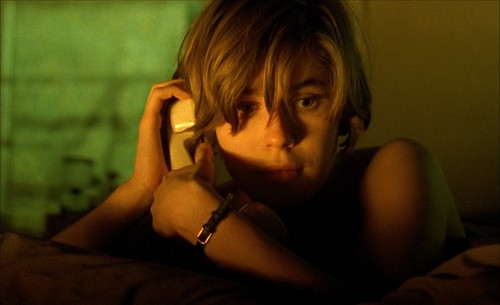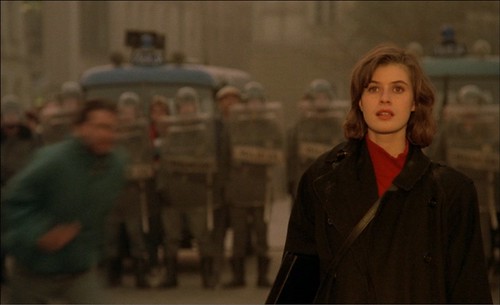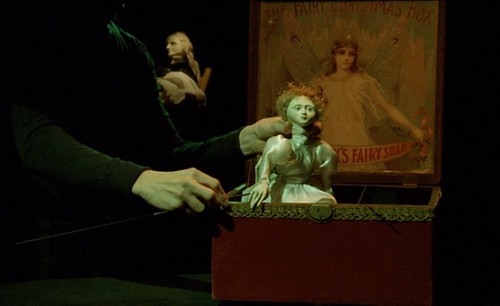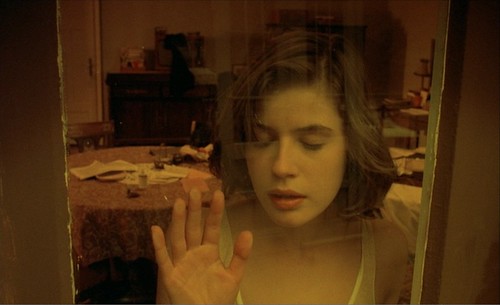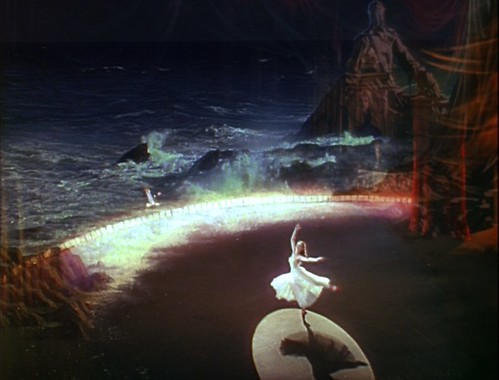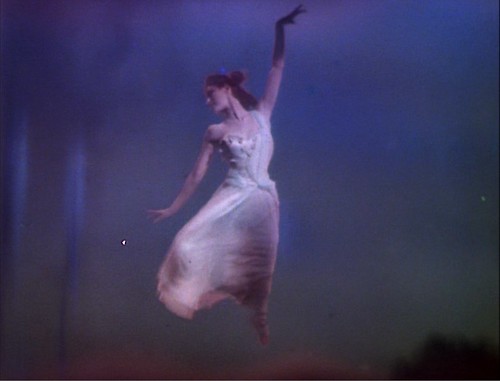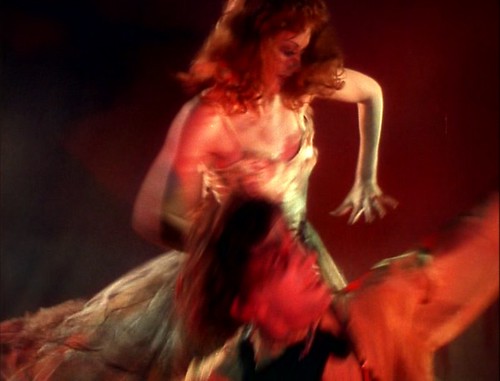Spoilers... You gotta be kidding me. You can't spoil this picture.
Director: Krzysztof Kieślowski
Screenplay: Krzysztof Kieślowski and Krzysztof Piesiewicz
Starring: Irène Jacob
Score: Zbigniew Preisner
Cinematographer: Sławomir Idziak
Editor: Jacques Witta
Images from the 2006 Criterion Collection release*.
Since I’ve built it up so much, what is The Double Life of Veronique about? Admittedly, I cringe at this question, because the thing is, whenever someone asks me about a movie, it’s invariably about “the story.” For me, the story as it relates to plot is painfully uninteresting most of the time. What interests me are characters, atmosphere, emotions, feelings and ideas. The Double Life of Veronique is all of these things, blossoming into a phenomenon that the filmmaker speaks through, reaching audiences on a spiritual level rather than merely an intellectual one. It’s often called “metaphysical” and while that’s perfectly apt, people can be left content to leave it at that without digging deeper.
It’s a bit hackneyed, but The Double Life of Veronique is a film of feeling more than cold, clinical camera movements, and looking at our emotional responses to it is maybe the best way we can render meaning. In a sense, the film is like music: Something that is difficult to articulate meaning from, but is somehow uncommonly effective in swaying our emotions. The Krzysztof Kieslowski/Zbigniew Preisner collaboration is one of the best director/composer teams (along with David Cronenberg/Howard Shore or Alfred Hitchcock/Bernard Hermann), in part because Kieslowski involves Preisner from the very beginning of the screenplay. Preisner’s scores, for me, are some of the most unique, evocative pieces I’ve heard in films. Like Kieslowski, I’m not good at critically evaluating music, but I know what works in a film. The score for The Double Life of Veronique, for me, evokes the delicacy of not merely life, but of beauty, music, images, and love, as well. Balancing life is as much of a tight-wire balance as Veronique holding her notes in tune. Lives can just as easily waiver and collapse altogether.
If The Double Life of Veronique evokes a feeling of vulnerability, it also brings a feeling of intimacy that can best be described as cinematic lovemaking. The scenes that exemplify this are the ones where we simply observe Veronique alone. Or is she alone? Aren’t we, the audience, always accompanying her? Isn’t it the medium of film that allows our minds to merge with her into a single disposition? She is often seen seemingly alone, but aware of something else. Perhaps this is her double, or perhaps it is a spirituality present between all human beings, including the audience.
Like The Red Shoes, The Double Life of Veronique can be seen as a rumination on the divisive forces of vocation and love life (and by extension, a simple, quiet life). The two women played by Irene Jacob: Weronika and Veronique, are perhaps two sides, or rather two possible outcomes, of the same person. Weronika forsakes her love life to aspire to the very limits of a singer’s potential. Her weakened heart, perhaps included because of Kieslowski's own heart condition, is representative of the choice between commitments: to a profession or to a love life. Veronique is the heads to Weronika’s tails, forgoing her potential as a great singer, choosing in the end not so much a love life, but rather yearning to regress to a simpler, childhood-like state.
There is a similar progression throughout Kieslowski's oeuvre, in which the filmmaker transitions to increasingly intimate and personal work. Beginning as a documentary filmmaker, his pieces from Poland are closely tied to the nation’s communist history. Kieslowski then began a transition to fiction because he felt he was using the people he documented and had no right to film such personal events. Throughout his fictions, we see a filmmaker more and more concerned with the internal, eventually turning his back completely on the politics that populated his earlier works. This progression reached its apex with The Double Life of Veronique, his most intimate work. This is almost a declaration from Kieslowski, as Weronika moves in the opposite direction of a political rally, completely unconcerned because she has just seen her double. The films of Three Colors: Blue, White, and Red present a kind of reversal to this, moving backwards from solitary freedom to an affirmation of fraternal love.
Has there ever been a film so intricately and intimately connected to its filmmaker? The film begins with Veronique as a child and ends with her returning to her father’s house: to the safety of the paternal hearth. When Kieslowski announced his retirement, perhaps he, like Veronique, wished to return to his childhood, or rather, a life of simplicity away from the chaos of filmmaking. Yet isn’t he also, like Weronika, an artist who pushed himself so far, that in the end he simply burned out way ahead of his time? There is little doubt that these two women represent Kieslowski's own internal struggles, yet he is suffused into virtually all the main characters here, from the papas of Irene Jacob to Alexandre.
It’s interesting that I chose to write about The Double Life of Veronique right after The Red Shoes. The films deal with the dichotomous pull between life and vocation, and both have a performance in the middle that reflects much of what the films are concerned with. “The Red Shoes” ballet is a more grand departure from the reality of the film it’s in, but the puppet show’s purpose in The Double Life of Veronique is, for me at least, twofold. It is first a reflection of the larger reality of film, with Alexandre as the puppeteer that, much like the film director, controls the movements of the characters in his play. It is also reflective of the yearning for the simplicity and safety of childhood.
What makes this such a personal film is that Kieslowski is inside so many characters. His life seems eerily connected to Veronique, but is he not also present as Alexandre? Alexandre’s influence on marionettes is extended to reality when he lures Veronique to him as if she’s merely a puppet being guided by his invisible wires. Kieslowski, too, is an unseen, yet ever present force guiding these character’s actions. Many of his films, with The Double Life of Veronique in particular, evoke the visual motif of glass. Kieslowski will distort the screen or create reflections as if inviting us to look at the world differently.
Glass, which is often a physical barrier (like in Playtime), isn't used that way here, I think. Kieslowski instead uses it as a connective, rather than divisive, force. It's as if he's emphasizing some invisible (or barely visible) connective thread. The love scene after Weronika's death is distorted by a crystal ball or fish eye lens, not only creating a surreal atmosphere, but perhaps reminding the viewer of the camera's presence. Or consider the shot below. Weronika approaches the window, as if regarding the camera itself. She then sees an old woman carrying groceries and offers to help. The commentary says Kieslowski included this because he was guilty, having made fun of the elderly in his youth. Perhaps, then, Kieslowski is asking for a second chance through the film medium, atoning for his mistakes and speaking through Irene Jacob with an offering of help rather than ridicule.
Veronique is hurt by Alexandre, feeling he subverted her emotions in wooing her not out of love, but out of profession. The film, in this sense, plays like a filmmaker’s confession, with Kieslowski torn by the intimacy of his profession. Like Alexandre, Kieslowski is perhaps saying that his role as director involves asking the actors to expose and make themselves vulnerable for the sake of the film. Alexandre’s motives may originate from an almost scientific pursuit in creating his fiction, but there is a moment when he recognizes both the harm his experiment has caused, as well as the human being he’s come to love (yet he'll still use her double life for his work, ultimately pushing her away). Kieslowski is perhaps not so much in love with Irene Jacob, but rather comes to the realization that the director-actor relationship (or any filmmaking relationship) cannot simply be a business pursuit where everyone has a contract and adheres to the stipulations thereof. There must be a kinship and empathy amongst the crew if the film is to thrive. In a sense, they must become a family: a singular unit working for the sake of the film (seen in Day for Night).
If we consider the puppet show in the context of the opening and closing passages of the film, there is, perhaps, a yearning to regress to a child-like state. The first scene shows Veronique and Weronika as children, being asked by their mothers to look at something in a new, different way. Children are capable of seeing the world in such a strange, upside-down perspective, and throughout the film, Veronique seems to be within this mindset. Much of the film is concerned with approaching the world from a new angle, with its kaleidoscope-like shots, upside-down images, gold and green exposures, distortions in the image, and subjective camera angles. The world of this film is, like the molten Earth, changing and malleable. The distortions suggest a universe that is tearing at the seams, not in any apocalyptic way, but in a manner that implies alternate realities we are given glimpses of like peering through a keyhole.
If we take the “double life” of Veronique as a musing on possibilities, then the two stories come to represent a kind of crystal ball. In the first, Weronika makes a choice that determines her demise. Perhaps, then, these events do not occur consecutively, but rather parallel to one another: not reflecting reality so much as the possible outcomes within reality. Veronique then becomes the alternative, shying away from her calling as a singer in exchange for love, but subsequently shying away from love as well and returning to her cinematic papa (the trunk of the family tree, so to speak). In thinking about the film this way, it becomes not so much like The Red Shoes, but almost a backwards coming of age tale, musing on a reversal of maturity.
The meaning of The Double Life of Veronique is fluid and changing. Nailing it down seems to make it all the more slippery, and there are so many approaches to such a strange, yet miraculous, piece of cinema. Kieslowski said this film is about things that cannot be named, or that doing so reduces it to something silly. In a sense, analyzing films is a bit silly, but thoughts should not be discouraged by Kieslowski's open-endedness. What results is a blossoming of interpretation. The work is almost unclassifiable. While so many films depend on plot as a krutch, The Double Life of Veronique could be argued as a more pure form of cinema, like a work of abstract filmmaking. The diverse number of essays on The Double Life of Veronique and the 20 some versions of the film Kieslowski prepared attest to a work that hearkens not to a concrete reality, but rather a fluid possibility.
----------------------
* I don't normally do this, but The Criterion Collection has put out an incredible DVD of The Double Life of Véronique which is probably my favorite from them. It is filled with insights that expand, rather than limit (as these things tend to do for me) my own interpretations of the film.
